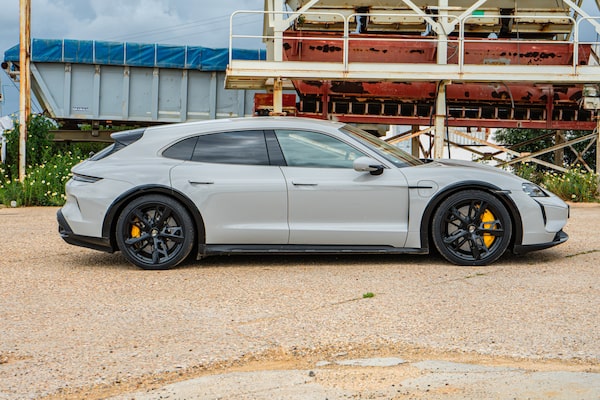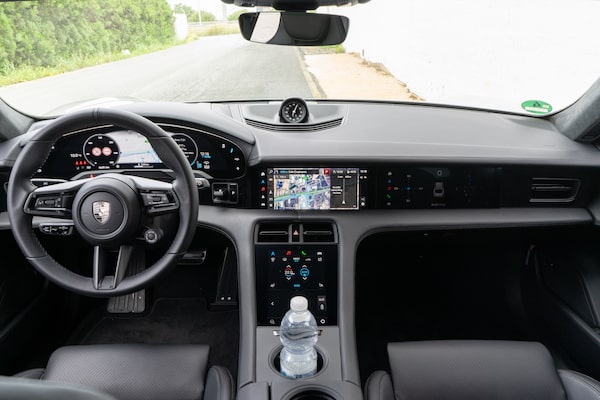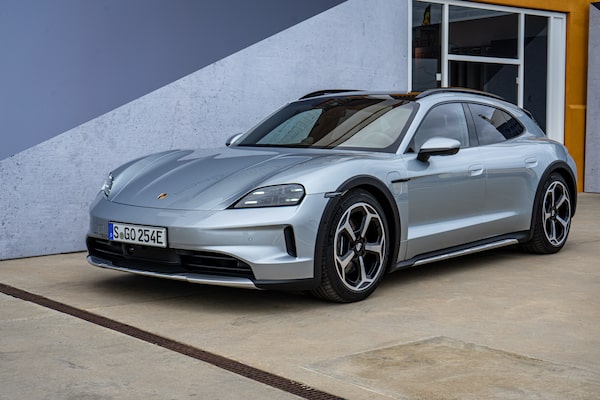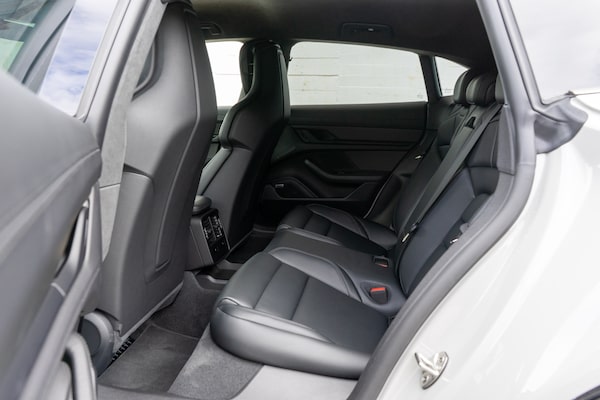
The new Taycan is more efficient with up to 34-per-cent more range.Kunal D'souza/The Globe and Mail
The Taycan was Porsche’s first all-electric vehicle of the modern era when it arrived in 2019 and it was everything you’d expect from a brand obsessed with motorsport. It showed everyone that electric cars could also be good sports cars, not just straight-line rockets. The Taycan even set a Nurburgring lap record for production EVs, which ignited a rivalry with Tesla that then released the Model S Plaid to claim the lap record for itself. With that kind of performance, it didn’t matter what powered these vehicles and all the politics surrounding them faded.
The Plaid is cool, but the Taycan is the far more desirable automobile. A row of them parked outside our hotel would make anyone with a passing interest in cars weak in the knees. With an elevated colour palette, exotic curves and hardware more suited to a racetrack than the street, the new Taycan is a Porsche first and an EV second. And it’s been extensively refreshed for the 2025 model year.
There’s been subtle tweaks to the styling with new bumpers and updated lighting, but all the notable stuff is under the skin. There’s more power, a bigger battery, increased range and updated tech. There’s also a sedan and cross turismo (wagon) body style and about a million different ways to configure them.
All Taycans benefit from a new, more powerful rear axle motor and the optional bigger battery grows to 105 kilowatt-hours with a usable capacity of 97. Utilizing a new chemistry, the larger battery is lighter that the outgoing unit and can charge at speeds up to 320 kilowatts, a 50-kilowatt increase from before. Porsche says charging performance is up in colder temperatures and it can remain at peak charging speeds for a longer period of time. This means that even with more capacity the bigger battery can charge from 10 to 80 per cent in 18 minutes, three and half minutes quicker than before. The smaller battery has a usable capacity of 82.3 kilowatt-hours and is standard equipment on the Taycan 4S.
Prices for the 4S start at $135,600. The Turbo S Cross Turismo is the most expensive variant before jumping up to the all-new Turbo GT and will set you back $238,200. If you’re at all familiar with Porsche pricing and options you’ll know that these represent mere starting points to build on as shown by our testers, some with more than $75,000 worth of extras.
Porsche didn’t just increase the power, the new Taycan is more efficient with up to 34-per-cent more range, not all of which comes from the bigger battery. The drivetrain is more efficient now and there’s a revised thermal management system, a next-generation heat pump, and the vehicle weighs slightly less. The regenerative brakes can also recuperate energy at a rate of 400 kilowatts under heavy braking. All of this contributes to an estimated range of 558 kilometres for the Turbo S.
The new rear axle motor adds an additional 80 kilowatts (109 horsepower) of power, meaning that even the 4S with the big battery makes up to 590 horsepower and 523 lb-ft of torque. These are incredible numbers for a base model, but it doesn’t even start to prepare you for the new Turbo S, which puts out 938 horsepower and a scarcely believable 1,110 lb-ft of torque. That’s about seven Toyota Corollas worth of twist.
These massive numbers are thankfully backed by a chassis that can handle it. Out on the sinewy tarmac that meanders through the Spanish countryside, the Taycan Turbo S is in its element. Glass smooth roads make forward progress easy and the grip from the 305-millimetre-wide rear Pirellis is unrelenting. The 2025 Taycan is available with Porsche’s new Active Ride, a trick suspension system that is designed to keep the body level at all times. It keeps the Turbo S perfectly flat during heavy cornering and large bumps are swallowed like they don’t exist.
The adaptive air suspension also does an excellent job of maintaining a civilized ride, but even a base Taycan rides stiffly when compared to something like a Mercedes-Benz or a Lexus. It is a sport sedan after all.
The Taycan feels light and responsive behind the wheel. Four-wheel steering helps mask some weight, but it’s the balance through the corners and how natural everything feels including the powertrain that makes it so enjoyable to drive. The steering wheel provides real feedback and if you exit a corner with too much haste the rear end will swing out but not in a way that’s scary. It’s an approachable and easy car to drive.
When an opportunity arises to explore the nearly unlimited reserves of power you’ll need to prepare your mind for an experience that could probably only be replicated by a Formula 1 car, or a Saturn V rocket. A small button on the drive mode selector unlocks an additional 94 horsepower for 10 seconds of insanity. Porsche calls it “Push to Pass.” The Turbo S can rocket from a standstill to 100 kilometres an hour in 2.4 seconds, but it feels faster than what that rather conservative time suggests. Even the entry-level 4S makes more power than you’d ever need on public roads.
It’s all a bit ridiculous to be honest because there’s just no where on earth to safely use this level of power and speed outside of a racetrack. And I get the feeling that we’re only scratching the surface of what’s possible. There’s really nothing to critique about the Taycan either. It feels a bit soulle but as an electric sport sedan, it’s essentially perfect. If you have the money, it’s the best there is.
Tech Specs
2025 Porsche Taycan Turbo S Cross Turismo
- Base price / As-tested: $238,200/$292,600 plus $2,950 for freight and pre-delivery inspection, plus tax
- Powertrain / Battery: Dual electric motors, 938 horsepower (combined); 818 lb-ft of torque (1,110 with launch control which is only available for a few seconds) / 97 kilowatt-hours (useable)
- Transmission / Drive: Two-speed /all-wheel drive
- Energy consumption/range: To be announced / 558-630 kilometres
- Curb weight: 2,355 kilograms (5,192 pounds)
- Alternatives: Audi e-tron GT, Tesla Model S, Lucid Air, Mercedes-AMG EQE, BMW i5 M60
Looks
Only Porsche-philes would be able to pick up the differences in styling from the last version, but the refreshed Taycan is an exotic and voluptuous sedan with a 911-like fastback roof and some epic new colours like Provence and Frozen Berry to help show off the new electric toy. There are new 21-inch aero-optimized wheels that look pretty cool but also add up to 40 kilometres of range.

The interior of the 2025 Porsche Taycan hasn't changed much, but the touchscreens have been updated.Kunal D'souza/The Globe and Mail
Interior
The inside hasn’t changed as much. Build quality and materials are beyond reproach and the touchscreens have been updated with an improved user interface and more functions. It’s not the roomiest sedan, but two adults in the rear’s sculpted seats would be quite comfortable even on longer drives.
Performance
This is the reason you buy a Taycan. The entry-level 4S has more than 500 lb-ft of torque and can sprint to 100 kilometres an hour in 3.7 seconds. And you can get it with the bigger battery and configure it to look just like the faster ones. Why would you possibly need any more speed? If you must, the Turbo S has more than 1,000 lb-ft of torque and shaves more than a second and a half from the 4S’s 0-100 time, which is ludicrous.

The 2025 Porsche Taycan Turbo S Cross Turismo has 938 horsepower from dual electric motors.Kunal D'souza/The Globe and Mail
Technology
The Taycan is nerdier than most Porsche’s and that’s saying something. There are no physical controls, just screens to control everything and even the air vents are annoyingly automated. It works well, though, and there’s a lot of tech working behind to scenes to make the Taycan as efficient as possible. Bombing around rural Spanish roads saw energy consumption in the neighbourhood of 25 kilowatt-hours per 100 kilometres, which is impressive.
The Taycan can now also charge at 320 kilowatts, which is impressive, and new cell chemistry makes the battery lighter and more power dense.

The rear seats are sculpted, which helps make long drives for adults in the back seat more comfortable.Kunal D'souza/The Globe and Mail
Cargo
The 84-litre frunk is useful for quick grocery runs or stashing a carry-on suitcase and both sedan and wagon have lots of space in the back for cargo. The Cross Turismo is the one you want if you do carry more stuff as it’s essentially a hatchback.
The verdict
The finest electric sport sedan on sale today.
The writer was a guest of the automaker. Content was not subject to approval.
Shopping for a new car? Check out the new Globe Drive Build and Price Tool to see the latest discounts, rebates and rates on new cars, trucks and SUVs. Click here to get your price.